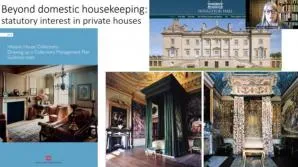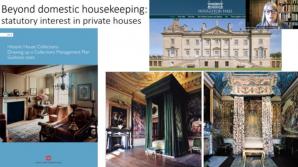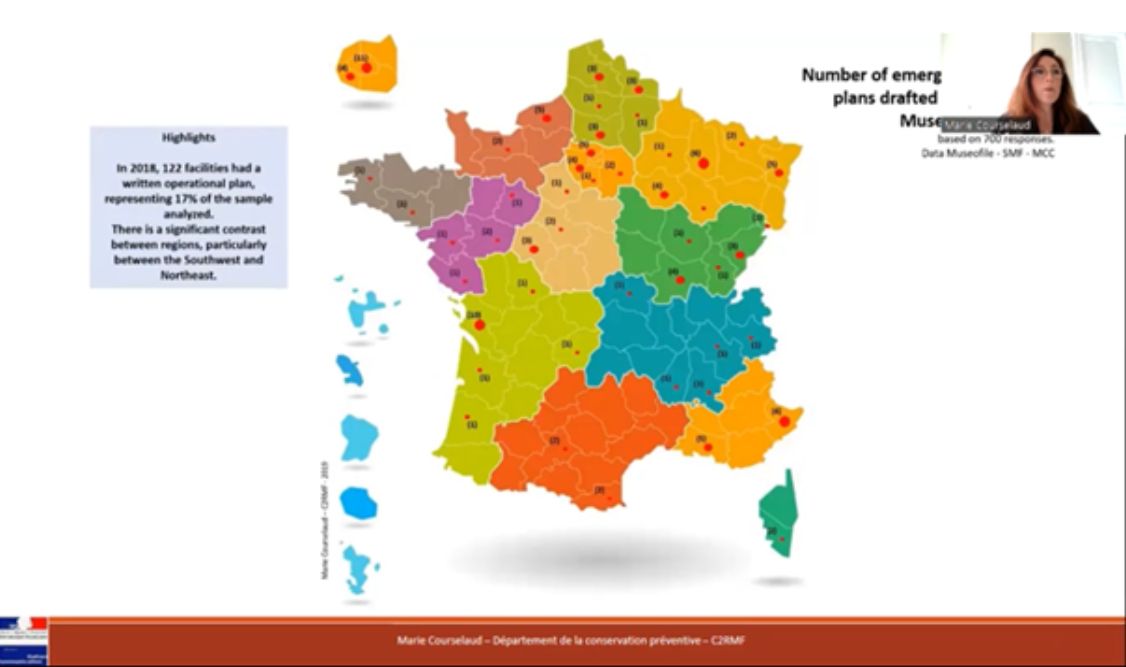Session 7
Submitted by sharragrow on 08 Sep 2022

Session 7: New Preventive Conservation Approaches (Part 1)
Reviewed by Roos van der Helm
A Long View Of Change In Caring For Historic House Interiors: From Housekeeping To Preventive Conservation, Collections Care And Beyond
Thursday's sessions started off wonderfully with Helen Lloyd and Katy Lithgow presenting their shared 73 years of experience in conserving historic house collections. Lloyd began by telling us all about the history and the evolution of the term housekeeping. She took us back to Europe long ago, when people started keeping house. During her talk we travelled to the middle ages, when windows and shutters became more common, something that is quite favourable for both people and objects. From there we skipped to the 17th century, when people stepped it up a bit and started using curtains and kept records of their housekeeping. Lloyd went on to explain that today's preventive conservators still use similar methods as were used in earlier times. Of course today it is also substantiated by scientific research and risk analysis. She gives the ABC method as an example.
Because of economic depression and post-war wealth taxes in the UK, historic houses fell into the care of public institutions and charities and often became museums. Because of this, a lot of houses were restored to their “best period” and removed later changes. It was only more recently that appreciation came for all the historical changes the houses went through. Because many traditional skills associated with the houses had disappeared over the years, there was no trust in the ability of these historical buildings to house important collections. The National Trust ordered an investigation in the rediscovery of these lost skills. This, combined with scientific research, resulted in the publication of the Manual of Housekeeping. Lloyd then explained that, as a result, historical house caretakers became more and more professional.

Lithgow’s presentation was more focused on the “now” of housekeeping, rather than the history of it. She explained how housekeeping has evolved from taking care of people and their objects to preventive conservation which benefits the public. Collections care measures, based on good housekeeping, benefit collections which feature quantity as well as quality by improving storage, monitoring and sensitive cleaning. This allows heritage institutions to expand their collections. Lithgow told us how the benefits of housekeeping go beyond the preservation of objects. Because of its traditional nature, housekeeping generally has a low carbon footprint and uses low energy methods. Lithgow added that it's time for conservators to step away from their invisibility cloak and to take credit for all the amazing work they do.
I must say I very much enjoyed the presentation. Next to being very informative, it was also quite amusing, with talks about cake and Harry Potter analogies. Although I thought this talk was very educational, I would have liked to hear more about the history of housekeeping in other parts of the world. Of course I do understand that both Lloyd and Lithgow gained their years of experience in the UK, and this was a fairly short presentation.
Emergency Response Plan Workshops: The Value Of An Interdisciplinary Collaborative Approach. An Innovative Methodology At The Service Of The Collective
The second speaker of the session was Marie Courselaud, with her presentation on emergency response plan workshops in France. The department that Courselaud belongs to came up with a method for drafting emergency response plans to assist museums. The method is adaptable to fit all heritage sites, in all regions and in all countries, and is freely accessible on the Citizen RMF website.
Citizen RMF started this project because research showed that only 17% of French museums had a salvage plan, and only 20% had salvage materials. These statistics are concerning considering the risks that museums face. They concluded that in order to change these numbers, action had to be taken. When interviewing museum colleagues, Courselaud’s team found that many museums lack the time and skills for drawing up plans. The interviewees wanted tools to help them with their response plans. That is why Citizen RMF published their adaptive method.

Courselaud then went on to tell us about the workshops they designed for museums; they consist of 6 sessions. The first session includes a museum visit during which risks are assessed. The museum is then given homework for the next session. The second meeting is all about prioritising collections. The third focuses on the identification of salvage, and during the fourth, human and material needs are discussed. During the fifth session, the museum staff makes an emergency response plan. The last session consists of an exercise to test the knowledge of the participants. The results are extremely positive and are being extended to Belgium as well.
Courselaud describes a problem which is very relevant in the museum world; many museums worldwide don’t have an emergency response plan or related training, even though they house important and unique historic objects. I’m really happy to see that organisations like Citizen RMF are taking the initiative to help museums with their emergency response preparations. Knowing what to do in an emergency situation will make such occurrences much less stressful and will limit damage.
Image Captions:
Image 1: Screen shot from A Long View Of Change In Caring For Historic House Interiors: From Housekeeping To Preventive Conservation, Collections Care And Beyond.
Image 2: Screen shot from Emergency Response Plan Workshops: The Value Of An Interdisciplinary Collaborative Approach. An Innovative Methodology At The Service Of The Collective.